Garmisch-Partenkirchen is one of Germany's most prestigious Alpine destinations, located at the foot of Germany's highest peak, the Zugspitze.
Originally two distinct communities, Garmisch and Partenkirchen each maintain their unique character. Partenkirchen, the older of the two, can trace its history back to Roman times. Its narrow streets and elaborately painted façades (Lüftlmalerei) preserve the atmosphere of a medieval trading town.
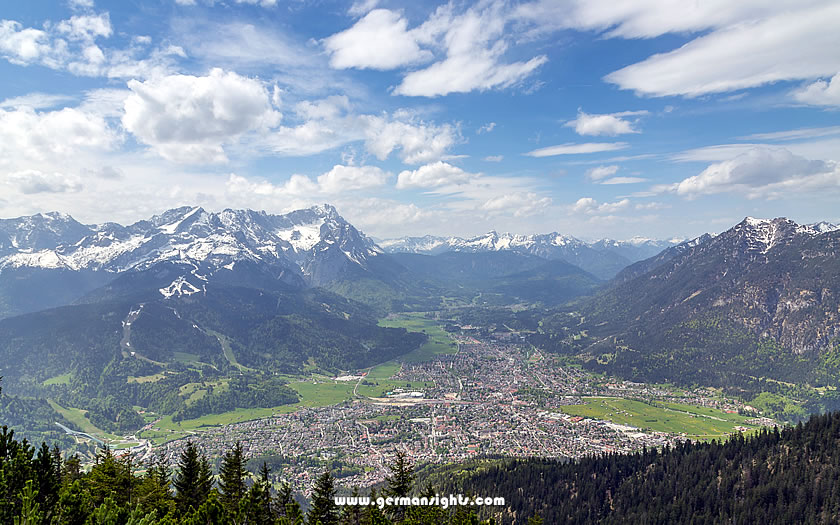
View over Garmisch-Partenkirchen in southern Germany
Garmisch, on the other hand, has a more cosmopolitan feel, with its stylish shops, upscale hotels, and modern sporting facilities.
The town rose to international attention when it hosted the 1936 Winter Olympics, an event that established it as a world-renowned winter sports destination. This legacy continues with top-class skiing facilities, the renowned New Year's ski jumping competition at the Olympic Ski Stadium, and year-round winter sports training.
Yet Garmisch-Partenkirchen offers much more than just winter activities: it's a year-round destination that combines outdoor adventure with a touch of cultural sophistication.
What also sets Garmisch-Partenkirchen apart is its dramatic natural setting. The town is surrounded by a amphitheatre of peaks, including the 2,962-metre-high Zugspitze, the Alpspitze and the Waxenstein group.
Garmisch-Partenkirchen is located in the Werdenfelser Land region of southern Bavaria, roughly 90 kilometres south of Munich, in a wide valley where the Loisach and Partnach rivers meet. The town occupies a strategic position at the northern edge of the Alps, and is the last major settlement before the Austrian border.
The town's geographical position makes it exceptionally accessible despite its mountain setting. A main railway line from Munich runs through here, providing direct access to the German rail network, and the nearby A95 motorway offers efficient road access.
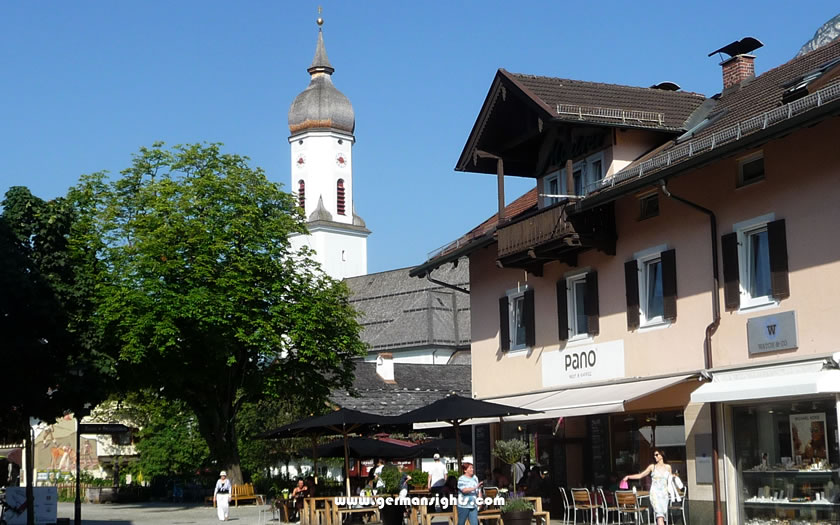
Garmisch town centre
Its proximity to Munich International Airport, about two hours away by car or train, makes it a convenient destination for international visitors. Innsbruck, Austria lies just 60 kilometres to the south, accessible via the spectacular Seefeld mountain pass.
What makes Garmisch-Partenkirchen's location particularly special is its position within a unique climatic zone. The high mountains protect the valley from severe weather patterns while creating excellent conditions for both summer and winter activities. The area receives reliable snowfall in winter, particularly at higher elevations, while the valley enjoys a relatively mild climate during summer months, making it ideal for hiking and other outdoor activities.
The town's location also places it within easy reach of several other notable Bavarian attractions. The fairy-tale castle of Neuschwanstein is about an hour's drive away, while the Benedictine monastery at Ettal and the Linderhof Palace are even closer. This central position in the Bavarian Alps makes Garmisch-Partenkirchen an excellent base for exploring the wider region, whether visitors are interested in natural, cultural, or historical attractions.
Most arrivals by air are probably going to be via Munich airport, despite the fact that an Austrian airport is quite a lot closer.
Distance to Innsbruck Airport: 59km
Distance to Memmingen Airport: 134km
Distance to Munich Airport: 136km
Innsbruck Airport has a surprisingly good range of summer flights (and an even wider selection in the winter) and train connections through to Garmisch-Partenkirchen via the Seefeld plateau.
Munich is however one of the largest airports in the country and the road and rail links to Garmisch are excellent (apart maybe from the last section of road from the end of the motorway at Eschenlohe).
Allgäu Airport at Memmingen may be just as close but has a comparatively limited range of flights and more problematic public transport.
Garmisch-Partenkirchen train station is located just about at the dividing line of Garmisch and Partenkirchen. There are regional rail services north to Munich and south to Mittenwald and, eventually, Innsbruck in the Austrian Tyrol, as well as a regional service through the Austrian area of the Ausserfern and on to the Bavarian town of Füssen (near Neuschwanstein Castle).
The resort town of Garmisch-Partenkirchen is situated in a wide bowl and surrounded on three sides by impressive mountain peaks. The two different parts to the resort - Garmisch and Partenkirchen - can be thought of as being on either side of the main railway line from Innsbruck to Munich (practically if not entirely accurately!) with Garmisch to the west and Partenkirchen to the east.
The main road from the Munich motorway in the direction of the Austrian border runs through the Partenkirchen side, while the country route through the mountains in the direction of Füssen and Reutte follows the Loisach river through Garmisch.
The resort is a busy one with plenty of through traffic and nearly 10,000 guest beds - Partenkirchen has tended to be the quieter of the two parts of the town.
If you know when you are planning to go but haven't decided on accommodation, then use the map below to get an idea of which properties are available and to compare prices during the period you wish to travel.
Enter your proposed dates and use the '+' to zoom in on a location and reveal more properties. Click on the price above a property to see more information.
(Please note that this selection will also include some guesthouses, pensions and self-catering apartments for those who are interested in that form of accommodation!)
Alternatively, if you would like a list of properties available on your proposed dates of travel, use the search box below to find accommodation:
The Roman trade route, the Via Raetia, once led around the base of the Wank mountain to the trading post of Parthanum - a forerunner of the present Partenkirchen.
What is now the quieter end of the resort was once a bustling centre of commerce along the important route between Venice and Augsburg, while Garmisch was more of a farming area settled by the German tribes.
After the decline of the Roman empire the trade route over the Seefeld plateau down to Innsbruck kept its importance and the towns - still separate - flourished from the resultant commerce.
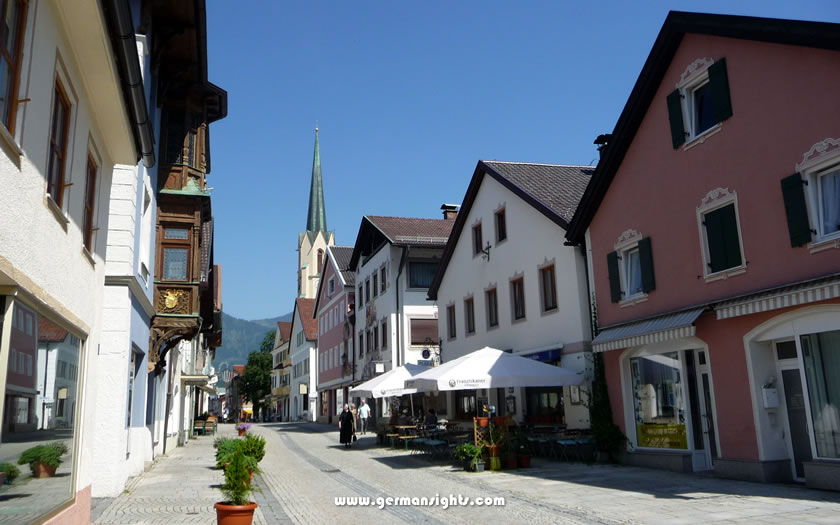
Ludwigstrasse in the centre of Partenkirchen
Like many of the riverside settlements in southern Bavaria, the town also benefited from the use of water as a means of transport and the transshipment of goods onto raft traffic on the the River Loisach was another important source of income.
Once trade with Venice was not as important, the income dried up and, combined with the effects of continuous religious wars, the area's prosperity declined.
What boosted Garmisch and Partenkirchen once again was the growth in tourism in the 19th century. Artists were the first to visit, followed by other sectors of German society once the rail line from Munich was finished in 1889.
Tourism boomed in the former market towns and the final impulse towards worldwide recognition came with the award of the 1936 Winter Olympic games. Apparently somewhat unwillingly, the separate towns of Garmisch and Partenkirchen were ordered to combine for the event and the resort of Garmisch-Partenkirchen came into being.
Nowadays the town is one of Germany's top holiday destinations, with a lively summer and winter season, as well as being a favourite day trip for those living in the Bavarian cities to the north.
The year 1936 was the last when both Summer and Winter Olympics were organised by the same country.
Following the choice of Garmisch and Partenkirchen as the location for the winter games (Berlin was where the summer games were held) the two separate settlements were ordered to form a single town by the German government.
The Garmisch town council were threatened with imprisonment when they objected to the decision.
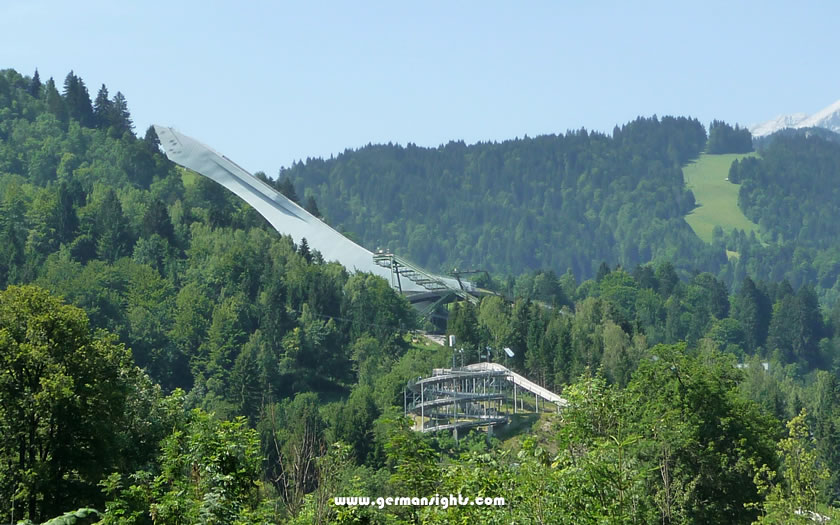
Ski jump in summer Garmisch-Partenkirchen
From a sporting point of view, the Garmisch-Partenkirchen winter games were notable for being the first time that Alpine skiing was included in the winter games. Competitive skiers who were also ski instructors were not allowed to compete, leading to a boycott by the Austrian and Swiss skiers.
The ice hockey stadium built for the games is still in use - although somewhat ancient these days - and is the home for SC Riessersee, a club who are former German ice hockey champions but who now play in the second tier.
The ski jumps have been remodelled and renovated although the ski stadium at the base remains from the 1930s.
One of the runs used for the downhill ski races is also still in use and is famous as one of the more difficult ski slopes on the ski racing circuit. The competition on the Kandahar piste is also one of the famous traditional group of ski races organised by the Kandahar Ski Club.
Garmisch-Partenkirchen ski resort has two main ski areas - the Osterfelder/Hausberg area above the town and the Zugspitze ski area on the glacier just under Germany's highest mountain.
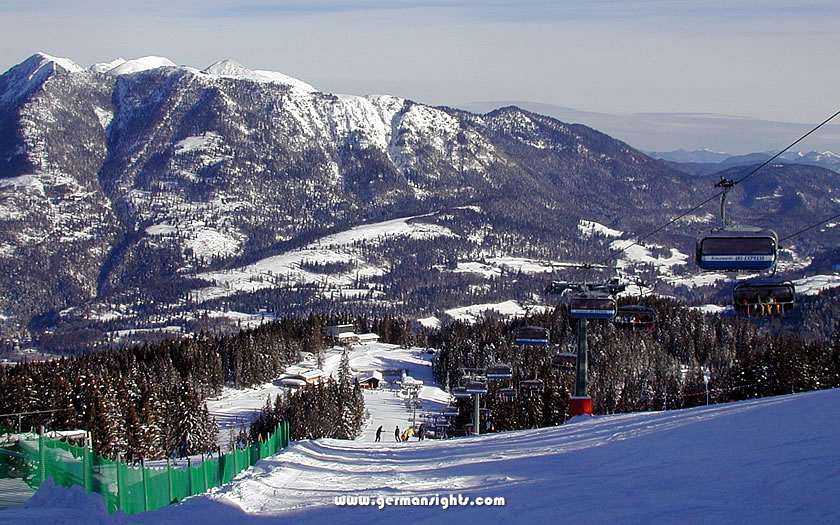
Skiing in Garmisch-Partenkirchen
There are three lifts leading up into different parts of the town ski area, all reached by ski bus or from stops on the Zugspitz railway. The Zugspitze ski area can be reached by the Bayerische Zugspitzbahn cogwheel train all the way from Garmisch-Partenkirchen town centre, or by a combination of rail and cable car from the Eibsee lake.
Garmisch is connected to an extensive network of cross-country skiing and walking trails, with snowshoeing also growing in popularity in the winter. There are two gorges with walk-through routes at each end of the resort - the Partnach gorge and the Höllental gorge - and the option of using the summer lifts to head up to the hiking area of the Wank; the spectacular Alpspix viewing platform below the Alpspitz; or the railway ride up inside the mountain to the Zugspitze.
The main Garmisch-Partenkirchen Tourist Office is located near the Congress Centre and Kurpark in Garmisch which is
open Mon-Sat year round. Another information office is available from Thurs-Sun at the Olympic Ski Jump. Out of office hours a map of Garmisch-Partenkirchen (with short descriptions of sights) can be purchased from a machine outside the main office.
Website: www.gapa.de